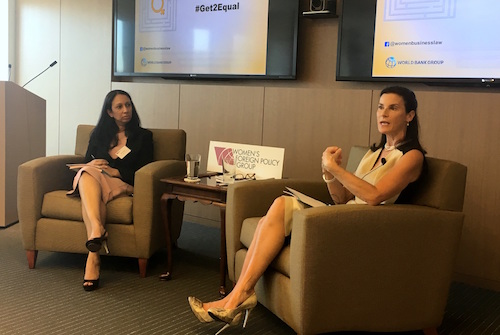Unequal in the Eyes of the Law: How Discriminatory Regulations
Impact Women Around the World
Sarah Iqbal, The World Bank Group
Sara A. Begley, Reed Smith (Moderator)
Photos | Key Findings | Report

Washington, DC—On May 3, 2018, the Women’s Foreign Policy group hosted a conversation on the World Bank’s newly released Women, Business and the Law 2018 Report with Sarah Iqbal, Program Manager of the World Bank Group’s Indicator Development Unit, and Sara Begley, Global Chair of Reed Smith’s Women’s Initiative Network.
“This was a watershed year for women,” Begley asserted as she opened the program. She went on to note that the word “feminism” was declared the number one word of 2017 by Merriam Webster Dictionary and that the #MeToo movement continues to bring to the forefront obstacles women face in the workplace. Despite the renewed attention, however, as the Women, Business and the Law report shows, these obstacles have a long history and policy has a long way to go in its efforts to reverse their effects. Men occupy 80% of power positions in leadership which has shaped institutions and cultures. Meanwhile, women globally are paid 23% less than men and make up 70% of the population in poverty.
The report, now in its 5th edition, studies 189 economies around the world. It examines the barriers and obstacles that women face in the workforce and in the legal sphere. A goal of the report is to determine which barriers are binding constraints on women, or those that prevent them from entering and remaining in the labor market. As Begley noted, “Women make up half the world’s population, and the global economy suffers because we are not participating.”
Iqbal noted that in her ten years of research at the World Bank, she has realized that many policymakers are not even aware of how their countries’ laws adversely impact women. “I don’t think that’s any intentional thing,” Iqbal noted. “They just don’t know what they don’t know and it’s not important enough to rise to the level of what they’re looking at.” She expressed her hope that this mentality might change with the rise of the #MeToo movement and increased attention to women’s rights. “It seems a really appropriate time to actually be bringing forth the data to get policy makers’ attention,” Iqbal said.
The report shows that many barriers exist at the legal level that prevent women from entering the workforce. One major barrier is a ban on women holding property or government IDs. These resources are essential for obtaining employment. There are also restrictions on job choice for women. 104 economies have at least one restriction on the jobs that women are allowed to perform. Some countries have specific restrictions, such as the Russian Federation, which has 465 specific jobs for which women cannot apply. Other countries’ barriers are more subjective, such as barring women from applying for “morally inappropriate” jobs. Countries that limit women’s employment opportunities the most are concentrated in Eastern Europe and Central Asia, rather than in the Middle East and North Africa, as many would assume. These types of restrictions on women’s decision-making have lasting impacts on their ability to assume leadership roles once they are employed, perpetuating the gender wage gap.
The report also looked at difficulties women face while trying to remain in the workforce. Notably, 59 of the surveyed economies have no legal prohibition on sexual harassment. In economies where such prohibitions do exist, data shows that there are more women in the workforce and more female entrepreneurs. Another obstacle that women face when trying to remain in the workforce is the availability of paid parental leave. The USA is one of seven countries in the dataset without paid parental leave. The report examined both whether paid leave meets the recommended ILO standard of 14 weeks and whether the government pays a portion of the leave. Iqbal noted that unsubsidized leave places the burden on employers and discourages the hiring of women of childbearing age. Additionally, lengthy required leave can disincentivize women from reentering the workforce by disrupting career tracks and professional connections. Though Iqbal stressed that more research is needed to determine the ideal length of parental leave, she emphasized that the end goal should be to reduce barriers to workforce reentry.
The data shows that beyond simply providing paid parental leave for women, it is important that fathers also have the ability, or even the requirement, to take parental leave. Low income countries typically have a high median amount of paid leave, but it is often not given to fathers. In order to keep women in the workforce, it is important that leave is not only made available but also culturally acceptable for men to take. So long as only women take leave, the barrier gender disparity will continue to exist.
The new report indicated some positive change. “We found that 65 economies made reforms toward gender equality,” Iqbal said. Kenya passed its first domestic violence law, and paid parental leave is becoming more common globally. Iqbal closed the program on a hopeful note, emphasising that there were very few negative reforms throughout any of the 189 economies. “We see good news happening. Overall, the trend is positive, but the pace is not happening fast enough.”
The full Women, Business and the Law Report 2018 is available here, along with key findings.
|